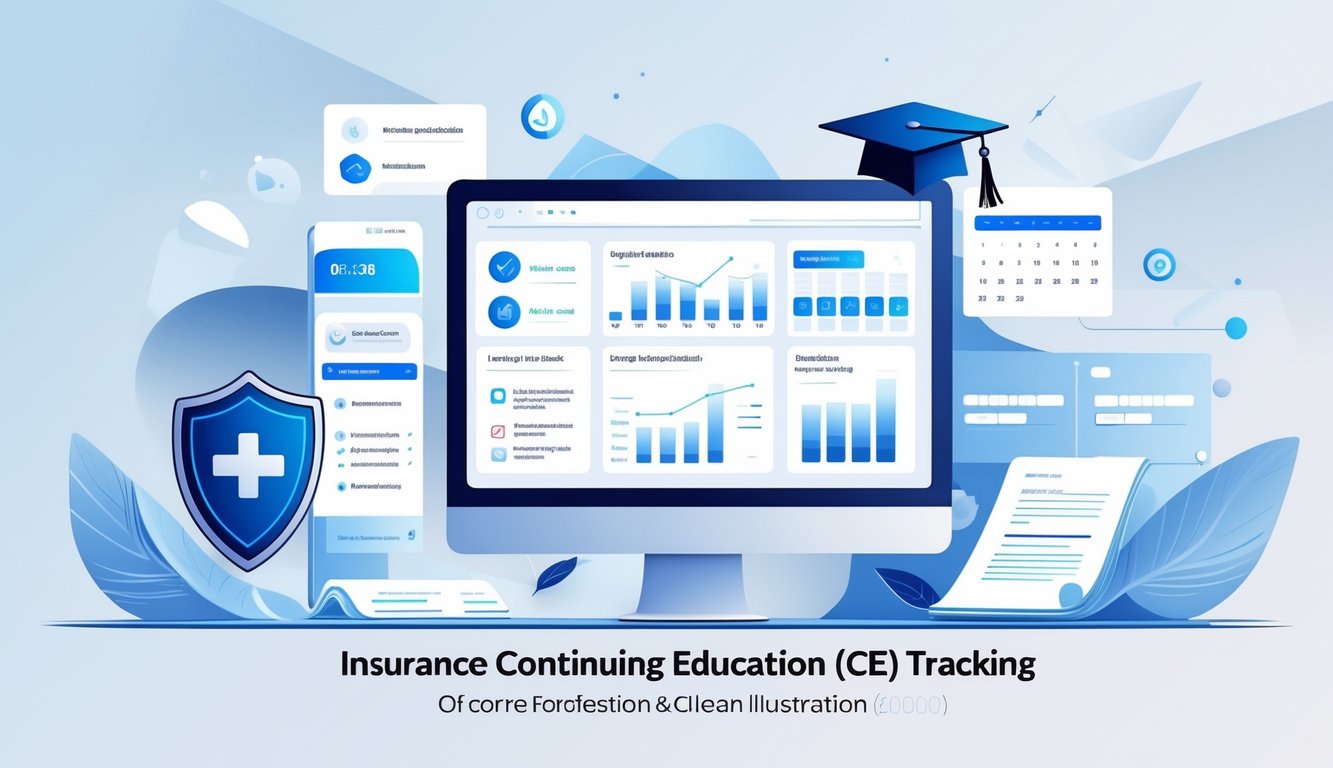Managing insurance continuing education requirements feels a lot simpler these days, thanks to digital tracking tools.
They handle deadlines, keep your certificates organized, and pull together compliance reports, all without you having to juggle paperwork.
These platforms let insurance professionals keep their licenses up to date, and honestly, they take a lot of the stress out of staying compliant.

Insurance CE tracking tools keep an eye on your credit requirements, ping you with deadline reminders, and save digital records of your finished courses. That means you get to focus on your actual work, instead of panicking over compliance issues or scrambling to handle last-minute deadlines.
A good tracking system saves you time and helps you avoid license lapses.
You’ll see what features matter most and how to pick a tool that fits your needs.
Key Takeaways
- Digital tracking tools handle CE compliance by watching your credits and sending deadline alerts
- Must-have features: course integration, reporting, and safe certificate storage
- The best system depends on your licensing rules and the size of your business
Core Features of Insurance CE Tracking Tools

Insurance CE tracking tools send out alerts for license renewals, track compliance status for different states, and sync up with online learning platforms.
These features help you keep your credentials active and cut down on boring admin work.
Automated License Renewal Alerts
You get automatic notifications when your insurance licenses are about to expire.
The system tracks renewal deadlines for every state where you’re licensed.
Most tools send you alerts at the 90, 60, and 30-day marks before your license runs out.
Some even up the frequency, sending weekly reminders during that last month.
Alerts can show up as:
- Emails
- Texts
- In-app notifications
- Dashboard warnings
You can tweak when you get these alerts.
Some folks like a bigger heads-up so they don’t get caught off guard.
The system keeps renewal dates for every license type you have—life, health, property, casualty, and any specialty licenses.
Compliance Monitoring Capabilities
A central dashboard shows your compliance status for each license.
The system matches up your completed CE hours with what your state requires.
You can check requirements by state, license, or topic.
Some states need specific hours in ethics, law, or product training.
Main monitoring features:
- Real-time tracking – Hours update right after you finish a course
- State-specific rules – Each state’s got its own quirks
- Audit trails – Full records ready for inspections
The platform points out any missing pieces in your CE record.
You see at a glance which courses you still need to stay compliant.
Color-coded indicators show green if you’re good and red if you need to act.
This makes it easier to figure out what to work on next.
Integration with Learning Management Systems
Your CE tracking tool connects with online training providers, so your course completions update automatically.
You won’t have to enter data by hand.
Popular integrations include WebCE, Kaplan, and American College.
The system grabs your certificates and transcript data right from these platforms.
Integration perks:
- Records hours for you
- Stores certificates instantly
- Cuts down on mistakes
- Makes your workflow smoother
If you take courses elsewhere, you can manually upload certificates.
The system usually accepts PDFs or scanned copies.
Some tools let you use single sign-on for multiple training providers, so you can launch courses straight from your dashboard.
Choosing and Implementing the Right Insurance CE Tracking Solution

Picking the right CE tracking tool means looking at features, pricing, and compliance needs.
Security and a good rollout plan help make sure things go smoothly.
Factors to Consider When Selecting a Tool
Cost Structure and Budget
Compare subscription fees, per-user pricing, and any setup charges.
Some tools bill monthly, while others offer better deals if you pay for the year.
Watch out for sneaky costs like data import fees or pricey support.
Figure out the total cost over a couple of years.
Feature Requirements
Decide what you can’t live without.
You’ll want basics like credit tracking, deadline alerts, and compliance reports.
Extras might include mobile apps, learning system integrations, or bulk user management.
Pick what actually fits your workflow.
User Interface and Ease of Use
Let your team try the platform before you commit.
If it’s confusing, people just won’t use it.
See if there are training guides or customer support.
Clear menus and labels make a big difference.
Scalability and Growth
Make sure the tool can grow with you.
Some platforms charge for each user, while others let you add as many as you want.
If you need to track licenses in several states or for different types, check that the tool can handle it.
Data Security and Regulatory Requirements
Data Protection Standards
Ask if the vendor encrypts your data, both when it’s stored and when it’s sent.
Look for SOC 2 Type II certification or something similar.
Find out where your data lives and who can see it.
Make sure they’ve got backup and disaster recovery plans.
Compliance Features
See if the tool tracks your state and license requirements.
Check that it updates automatically when rules change.
Audit trails and compliance reports are key, especially if your state asks for specific formats.
Privacy Policies
Read the vendor’s privacy policy.
Know what happens to your data if you cancel.
Make sure they won’t sell or share your info without your go-ahead.
Best Practices for Deployment
Planning Phase
Set a timeline and list out what needs to happen.
Pick your main contacts and give everyone clear jobs.
Collect your current CE data—spreadsheets, certificates, whatever you’ve got.
Clean it up before you import.
User Training and Adoption
Plan training for different groups.
Share written guides and videos so people can check back later.
Start with a small pilot group before going all-in.
Listen to feedback and tweak things as needed.
Ongoing Management
Set up regular reviews to keep your data accurate.
Assign someone to watch compliance deadlines and follow up if anyone’s behind.
Use automated reports for managers and make sure you have backups of important data.
Frequently Asked Questions

Insurance pros have plenty of questions about tracking CE credits and using these platforms.
Here are some common ones, along with quick tips.
What are the top-rated tools for tracking continuing education credits in the insurance industry?
CE Broker is by far the most popular choice for tracking insurance CE credits.
It automatically logs your finished courses and saves your credit history.
AgentCampus is another solid pick, with tracking and reminder features.
A lot of people use it for both courses and progress monitoring.
Some state insurance departments have their own online portals for credit tracking.
These usually sync up with approved education providers.
How do I verify my continuing education credits for my insurance license?
Log into your state insurance department’s online portal to check your official credits.
Most states update these records within a month of finishing a course.
If anything’s missing, reach out to your course provider.
They can send you certificates and help sort out reporting issues.
It’s smart to keep your own copies of certificates and transcripts too.
That way you’re covered during license renewal time.
Are there any free platforms available for tracking insurance continuing education courses?
Many state insurance departments offer free online portals.
These let you check your credit balance and renewal needs at no charge.
Some course providers also give you basic tracking through their student portals.
Free tools usually don’t have as many features as paid ones.
You might miss out on reminders, detailed reports, or integrations with several providers.
What is the process for logging into a CE Broker account?
Head to the CE Broker site and hit the login button up top.
Type in your username and password.
If you forget your info, use the “Forgot Password” link.
You’ll get reset instructions in your email.
Sometimes you need to pick your profession and state during login.
That makes sure you see the right licensing info.
Can CE Broker be used for tracking CE credits in professions other than insurance, such as nursing?
CE Broker works for a bunch of licensed jobs—nursing, real estate, healthcare, you name it.
The platform keeps separate tracking for each profession’s rules.
If you’ve got more than one license, you can use the same account.
It’ll keep your credits organized by profession and state.
Each field has its own CE rules and approved providers.
CE Broker adjusts its tracking tools to fit whatever license you have.
What steps should be taken if one is unable to access their CE Broker account?
Start by hitting “Forgot Password” on the login page.
Wait for the password reset email, then follow the steps they send.
If that doesn’t fix it, clear your browser cache and cookies.
Old data can sometimes mess with the login process.
Still stuck? Reach out to CE Broker customer support.
Let them know your account info and what error messages pop up.






